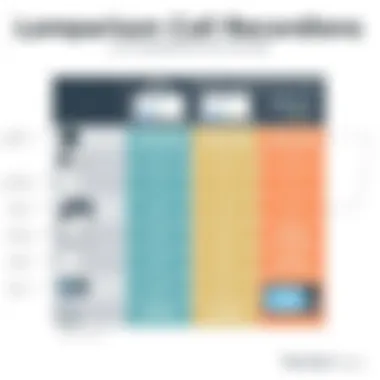Choosing the Best Call Recorders: A Comprehensive Guide


Intro
In today's communication landscape, the need for reliable call recording solutions is more significant than ever. Whether for businesses navigating regulatory waters or individuals seeking to enhance their personal note-taking ability, the importance of effective call recorders cannot be overstated. Not only do these tools allow you to capture essential conversations, but they also provide a means to revisit details that might otherwise slip through the cracks. The right call recorder can help improve transparency, accountability, and compliance in various contexts.
This guide aims to clarify the various factors at play when selecting a call recorder. It offers a thorough exploration of key features, pricing models, and some recommended options that suit diverse needs. As decision-makers navigate this technological terrain, understanding the essential elements of call recording technology will facilitate informed choices that align with their specific requirements.
Understanding these tools becomes critical as they evolve, reflecting changing user demands and regulatory landscapes. This article seeks to illuminate the available options, providing you with insights needed to determine which call recorder aligns best with your objectives.
Understanding Call Recording Technology
As we navigate through an increasingly digital environment, understanding call recording technology becomes essential, especially for organizations and individuals who need to secure, reference, or comply with communication regulations. Call recording plays a pivotal role in ensuring that critical conversations are documented, whether they’re for customer service, legal purposes, or internal communication. In this section, we will discuss the significance of call recording, the history behind its evolution, and how it operates under the hood.
The Evolution of Call Recording
Call recording has come a long way since its inception. Initially, it started as a rudimentary practice, often relying on tape recorders as bulky and cumbersome devices. It’s hard to fathom that just a few decades ago, businesses relied on analog systems that required meticulous care and maintenance. With the birth of digital technology, everything got a substantial facelift.
The leap from analog to digital recordings brought about a transformation that not only improved audio quality but also expanded storage capabilities. Companies were no longer limited by the length of tape. This transition coincided with the rise of VoIP and mobile communication, leading to the development of sophisticated software solutions that could record calls seamlessly over various networks.
Looking at today’s landscape, we find call recording is embedded within customer relationship management (CRM) systems and other business tools, making it more accessible and essential than ever. Businesses now possess the ability to analyze recorded calls through advanced software that utilizes machine learning and artificial intelligence, providing actionable insights and improving customer interactions.
How Call Recorders Work
At the heart of call recording technology lies its operational mechanics, which can vary based on the method of recording. However, fundamentally, call recorders operate by capturing audio from telephone calls, whether they be on traditional landlines, mobile phones, or VoIP systems.
There are two primary methods for recording calls:
- Inline Recorders: This approach integrates hardware directly into the telephone network. Inline recorders tap into the line, capturing audio as it travels back and forth.
- Software-Based Recorders: Software applications that run on computers or mobile devices intercept sound directly from the device’s microphone. This solution is often favored due to its flexibility and ease of use.
"Understanding how call recorders function can empower businesses to choose the most suitable solution for their operational needs, ensuring that they meet both their documentation and compliance requirements."
The recording process typically involves the following steps:
- Initiation: The recording can be triggered automatically, manually, or through certain conditions like the presence of keywords.
- Capture: The recorder captures audio in real-time, ensuring high fidelity.
- Storage: Once captured, recordings are stored, often encrypted, to maintain confidentiality and integrity.
Given the rise in regulations surrounding call recording, particularly regarding consent, understanding these mechanics not only helps businesses in operational efficiency but is also critical for adhering to legal standards. As technology continues to evolve, so do the methods of recording, leading to discussions on ethical practice and user consent that are central to this field.
Key Features of Effective Call Recorders
When diving into the world of call recorders, one quickly realizes that not all recording tools are created equal. The Key Features of Effective Call Recorders define how well they can serve their intended purpose, be it for personal use, business efficiency, or compliance with legal standards. Let's delve into these features, looking at the critical qualities every decision-maker should consider in their quest for the ideal call recording solution.
Audio Quality and Clarity
Audio quality is the bedrock of effective call recording. If a recording is garbled or unclear, it defeats its very purpose. High-fidelity audio ensures that every word is crisp and every tone is accurately captured. This is particularly crucial in business contexts where misunderstandings can lead to costly repercussions. So, how do you spot a top-notch recorder in terms of audio?
- Bitrate Matters: Look for recorders that support higher bitrates, typically measured in kbps. A higher bitrate results in a richer sound.
- Noise Reduction: Some call recorders come equipped with noise cancellation technology, filtering out unwanted background sounds. This feature can be a game changer in busy environments.
- Dynamic Range: A good recorder should have a wide dynamic range. This means it can accurately capture both soft whispers and loud conversations without distortion.
In short, clarity is non-negotiable. Users must prioritize recorders that can deliver pristine audio files.
User Interface and Ease of Use
Navigating technology can be tricky, especially for those who aren't tech-savvy. A user-friendly interface can make the experience of using call recorders significantly more enjoyable.
Understanding the layout, accessing features, and initiating recordings should feel intuitive. A few pointers to ensure you're selecting an easy-to-use recorder include:


- Simplicity in Design: Look for minimalistic designs where buttons and functions are clearly labeled. Clarity in use can often trump having tons of features.
- Tutorials and Support: Check if the software includes tutorials or customer support options. This can be a lifesaver for users needing assistance.
- Mobile Compatibility: With more professionals relying on mobile devices, check if the call recorder offers a mobile app that's equally intuitive.
A seamless user experience can lead to fewer headaches, more effective usage, and ultimately, better recorded outcomes.
Storage and Data Management
In an age where data is king, effective storage and management options are crucial for any call recorder. Call files can accumulate quickly; thus, having robust storage capabilities is essential.
- Cloud Storage Options: Seek out recorders that offer cloud integration. This allows you to securely store and access recordings from anywhere.
- File Organization: Good recorder software should allow users to categorize recordings easily. Look for tagging systems or folders to help keep track of numerous calls.
- Automatic Deletion Settings: Some applications offer options to automatically delete older recordings after a set period, helping to manage space without manual intervention.
Efficient data management ensures that crucial recordings are preserved while keeping the system neat and organized.
File Formats and Export Options
When dealing with call recordings, versatility in file formats and export options is another aspect that can't be overlooked. This ensures compatibility across various systems and devices and simplifies sharing among team members.
- Common Formats: Confirm that the recorder supports widely-used formats like MP3, WAV, and AAC. These formats ensure that files can be shared with others without hassle.
- Direct Sharing Features: Some tools allow users to share recordings directly via email or integrate with applications such as Slack or Google Drive. This can save time and streamline communication.
- Conversion Capabilities: Find out if the software includes conversion tools to change file formats easily, in case you need a different one for specific purposes.
In essence, diverse file formats and straightforward export options bolster the usability of call recordings, paving the way for effective communication and documentation.
In the world of call recorders, the right features can make all the difference. Selecting a device or application that excels in audio quality, usability, storage management, and format versatility is integral to achieving the best recording results.
As the market continues to evolve, staying updated on these key features will help users make informed decisions that suit their needs.
Legal Considerations in Call Recording
The realm of call recording is not just a technical concern; it's deeply intertwined with legal frameworks that guide how, when, and why calls can be recorded. Being well-informed about these legalities is crucial for anyone considering recording calls, whether it’s for personal purposes or for a business environment. Understanding the legal landscape can help avert potential pitfalls and ensure compliance with applicable laws, preserving the integrity and reputation of individuals or organizations.
Understanding Consent Requirements
Consent is the cornerstone of legal call recording practices. Different jurisdictions have varying laws regarding recording conversations. Generally, consent can be classified into two types:
- One-party consent: In these states or countries, as long as at least one participant in the conversation agrees to the recording, it can proceed legally. This simplifies matters significantly, especially in business contexts where employees might need to record calls for training or customer service improvement.
- Two-party consent: This is more stringent, requiring that all parties involved in the call give their explicit consent. Many states in the U.S., for instance, fall under this category. Failing to obtain consent from all parties can result in legal repercussions, including hefty fines.
"It's essential to know who needs to give the nod before hitting 'record'—this can save you from a world of trouble."
When dealing with call recordings, website links to resources such as the American Civil Liberties Union (ACLU) and local laws should be consulted to clarify specific requirements related to your area: aclu.org
Regional Legal Frameworks
The laws governing call recording vary significantly from one region to another. In the United States, for instance, the legal landscape is a patchwork of state laws. Some key points include:
- Federal law allows for one-party consent. This means, in most instances, if you’re part of the conversation, you can record without notifying the other party.
- State laws can differ greatly. California, for example, mandates two-party consent, which means no recording can take place unless all involved parties are aware and agree.
- International variations can be even more pronounced. Countries in the European Union follow the General Data Protection Regulation (GDPR), which emphasizes the protection of personal data and privacy, including approach to recordings.
Each of these legal frameworks exists to protect individuals from unauthorized invasion of privacy. Failing to adhere to these laws could lead to severe consequences, both legally and financially.
To navigate this complex landscape, consulting with legal professionals or organizations like the International Association of Privacy Professionals can provide clarity: iapp.org. Being informed about legal standards in your region not only aids compliance but can help foster a culture of respect and transparency in communication, essential for any business's long-term success.
Top Call Recorder Applications
When it comes to choosing a call recorder, the myriad of applications available can make the selection process feel overwhelming. However, understanding the importance of these applications is crucial for making a well-informed decision. Call recorder applications play a pivotal role in various sectors—be it for personal reference, business conversations, or compliance with regulatory requirements. Their ability to archive important dialogues can enhance communication strategies, improve customer service, and aid in dispute resolution. Thus, knowing the leading choices can pave the way for smarter choices in what to use and how to implement it effectively.
Overview of Leading Software Solutions


In the landscape of call recording software, a few standout applications have gained prominence due to their reliability and robust features. Notably, applications like Rev Call Recorder, Otter.ai, and Call Recorder - ACR have carved a niche for themselves in both personal and business use cases.
- Rev Call Recorder: This app stands out for its user-friendly interface and unlimited recording length with no hidden fees. Its ability to transcribe recorded calls is particularly useful for professionals needing quick summaries or quotes.
- Otter.ai: Known for advanced features, Otter not only records calls but also provides real-time transcription and collaborative editing. This application caters mainly to business environments where documentation of discussions is crucial.
- Call Recorder - ACR: This app shines with its comprehensive features, offering cloud storage options and various file formats. It's popular among users seeking versatility and reliability.
These applications not only enhance the recording experience but also incorporate unique functionalities that cater to diverse user needs. For anyone in the market for a call recording solution, these apps are worth considering.
Comparison of Features and Pricing
When evaluating call recorder applications, comparing their features alongside pricing can clarify the best fit for your requirements.
- Audio Quality: High-quality audio is essential for clear understanding. Rev and ACR are known for exceptional audio recording, often touted as top choices in this aspect.
- Transcription Services: Otter.ai leads the pack here, transforming recorded dialogues into written text efficiently. For those who prioritize this feature, its value in a professional setting can’t be overstated.
- Cloud Backup: Many applications, including ACR, offer cloud storage. This feature is vital for users who need to ensure that their recordings are safe and easily accessible.
- Pricing Models: Pricing can vary significantly; while some apps like Rev offer free unlimited use, others may charge monthly fees for premium features. Otter.ai has a free tier with limitations but offers paid options for more advanced users. ACR typically adopts a one-time purchase model or subscription-based pricing depending on the features chosen.
"The key to a successful call recording application lies in how it caters to your specific needs, be it simple recording, robust transcription, or secure storage."
By weighing these features against the costs, potential users can identify the best software appropriate for personal or professional environments. This detailed comparison can significantly enhance decision-making efficiency, ensuring that users choose not just any recorder, but the right one for their unique circumstances.
User Experience and Reviews
In the realm of call recording, understanding user experience and reviews is paramount. This aspect offers potential users insights into how well the software performs in real-world scenarios. When considering a call recorder, one should not overlook the value of peer feedback. It sheds light on the effectiveness of features, ease of use, and the overall reliability of the application in day-to-day use.
By tapping into genuine user experiences, decision-makers can weigh the pros and cons of specific call recorders against their own needs. Furthermore, testimonials often highlight hidden features that may not be evident from product descriptions or marketing materials. Reviewing how others have navigated common challenges can provide useful lessons and best practices for new users.
In addition, the information gleaned from user reviews can act as a valuable guide. Users often share insights about unexpected glitches, customer support responsiveness, and regularity of updates, all of which can affect long-term satisfaction. As such, a solid grasp of user experiences equips potential buyers with the knowledge needed to make an informed choice, ensuring that the selected call recorder aligns with their specific requirements.
User Feedback and Testimonials
User feedback serves as the backbone of a trustworthy call recording software evaluation. Authentic testimonials from various users offer profound insights that manufacturers may overlook or underplay. They provide a window into the practical aspects of using a call recorder, from sound quality to integration capabilities.
Here are some critical points to consider when analyzing feedback:
- Audio Quality: Many users emphasize the importance of clear audio recordings. Reports about background noise interference or muffling are invaluable when gaugeing sound fidelity.
- User-Friendly Interfaces: Testimonials often mention how intuitive or challenging a software's user interface can be. An app may boast extravagant features, but if users struggle to navigate, its utility diminishes significantly.
- Effectiveness of Features: Feedback often delves into how well specific functionalities, like transcription services or cloud storage, work in practice. Users frequently share experiences that can counterbalance marketing claims.
Collecting this type of information helps future users paint a more informed picture of what to expect. It's important to sift through reviews on multiple platforms, such as Reddit or tech forums, to get a well-rounded view.
Common Challenges Faced by Users
Even the best call recorder can come with its fair share of challenges. Acknowledging common issues faced by users can guide new adopters to plan for these obstacles, improving their overall experience.
Some prevalent hurdles include:
- Software Bugs: Issues like freezing or crashing during calls can happen, leading to missed recordings. Regular updates from developers can remediate these problems, but initial teething issues might frustrate users.
- Compatibility Problems: Users often report conflicts with existing systems or devices. Not all call recorders are created equal when it comes to compatibility with hardware, which can lead to additional costs or unwanted workarounds.
- Legal Misunderstandings: Confusion regarding recording consent laws can create complications. Many users highlight the need for clarity on regional regulations, emphasizing the responsibility to comply with legal frameworks.
- Storage Limits: Some users find themselves running out of storage space or having difficulty managing their recorded files. Understanding how each recorder handles data storage and retrieval is vital to prevent such disappointments.
By addressing these challenges head-on, users can better prepare themselves and seek solutions swiftly. This knowledge can enhance their call recording journey and ultimately lead to a more satisfactory experience.
Integration Capabilities
When it comes to selecting a call recorder, the integration capabilities of the software can make or break the decision for many organizations. As businesses increasingly rely on a mix of software tools to manage operations, ensuring that your call recording solution plays well with others becomes crucial.
Integrating a call recorder with existing systems enhances overall productivity, allowing seamless data flow and easy access to important records. This capability can lead to improved communication and more informed decision-making. If your call recorder can’t mesh with tools like CRM systems, project management software, or customer support platforms, you might find yourself swimming against the tide. Plus, the hassle of juggling multiple systems without proper integration could be a recipe for chaos.
Compatibility with Existing Systems
Compatibility with existing systems is foundational. Whether you’re using systems like Salesforce, HubSpot, or even simple Google Workspace setups, a call recorder that easily integrates can streamline workflows significantly. For instance, being able to have a recorded call automatically logged as a note in your CRM cuts down on the need for manual data entry and reduces the risk of misplacing important details.


- Why Compatibility Matters:
- Saves time and boosts efficiency
- Reduces the risk of manual errors
- Enhances user satisfaction and helps team collaboration
It’s essential to assess the specific systems you already have in place. Some call recorders might require additional plugins or configurations, while others can offer out-of-the-box compatibility. Always check if the call recorder supports the systems and applications your team relies on. Otherwise, you might end up with an incompatible solution that creates more issues than it solves.
APIs and Customization Options
Application Programming Interfaces (APIs) represent a significant aspect of modern call recorder technology. For organizations that require specific functionalities, the ability to customize integration options through APIs can be a game-changer. An API allows developers to connect different systems, facilitating data sharing and function utilization between various software applications.
- Key Benefits of APIs:
- Enable tailored solutions to fit unique business needs
- Allow for automated workflows that enhance productivity
- Offer scalability as business operations grow and change
Beyond just integration, customization is where you can address your team’s specific challenges. Say you need certain call data reviewed in a unique manner; APIs can help you program that function into your reporting dashboard, ensuring that what you need is readily available. However, bear in mind that some technical know-how may be necessary to tap into these capabilities fully.
In the evolving landscape of call recording solutions, selecting software with robust integration capabilities opens many doors to operational efficiency and effectiveness. As technology continues to evolve, those who embrace these integrations will likely keep ahead of the game.
Selecting the Right Call Recorder for Your Needs
Choosing the right call recorder isn’t a walk in the park. It's a nuanced decision that can influence how effectively you manage calls, whether for personal use or in a business setting. A call recorder that aligns with your unique requirements not only enhances efficiency but also safeguards vital information.
Factors such as audio quality, ease of use, and compatibility with existing systems aren’t just buzzwords; they are essential elements that shape your experience. Consequently, a careful assessment can help you sidestep potential pitfalls and find a solution that stands the test of time.
Assessing Your Requirements
Before diving headfirst into the myriad of options available, it’s crucial to lay down a clear understanding of what you need from a call recorder. Here are a few points that can guide your assessment:
- Purpose of Recording: Are you recording for legal compliance or just for personal reference? The answer significantly influences your choice. If legal compliance is paramount, you might need more robust features.
- Type of Calls: Is it mostly VoIP, cellular, or landline? Each medium has its unique challenges and requirements.
- Length and Volume of Calls: For high call volumes, consider a recorder with longer storage and faster access capabilities.
- Required Features: Think about whether you need features such as transcription, cloud storage, or integration with other software.
Taking a moment to jot these requirements down can be immensely beneficial. It allows you to proceed systematically, comparing models directly against your specific needs.
Budgetary Considerations
While quality is key, budget constraints are a reality for many users. Finding that sweet spot between functionality and affordability requires careful thought. Here are some pointers to keep in mind:
- Initial Costs vs. Long-term Savings: Sometimes, opting for a more expensive system can lead to savings down the road. For instance, investing in a call recorder that offers excellent reliability may spare you from frequent repairs or replacements.
- Subscription vs. One-time Payment: Many call recorders offer subscription models. Weighing these options can illuminate whether ongoing expenses fit within your business's financial plan.
- Hidden Costs: Be wary of those sneaky add-ons that some providers throw in. Whether it's storage fees or additional features, understanding the total cost of ownership is vital.
- Trial Periods: Look for options that offer trial periods. They provide a window for you to test the waters before committing, reducing the pressure of making a hasty decision.
Ultimately, making an informed decision about which call recorder fits your needs and budget can save you both time and money in the long run. The right purchase not only fits seamlessly into your workflow but also delivers on its promises, ensuring you don’t find yourself grappling with regrets later on.
Future Trends in Call Recording
The landscape of call recording is entering a transformative phase, significantly influenced by recent advancements in technology. As organizations and individuals continue to recognize the value of audio documentation, it's essential to explore these trends to stay ahead of potential shifts affecting their choice of recording tools. Here, we will delve into two major areas: the impact of artificial intelligence and the emergence of new technologies that promise to elevate call quality.
Impact of Artificial Intelligence
Artificial Intelligence is taking the center stage in revolutionizing call recording. One of the main advantages is automated transcription, which converts voice conversations into text with increasing accuracy. This is beneficial for busy professionals who need a written record but don’t have the time to jot down notes. Companies like Rev and Otter.ai are at the forefront, leveraging AI to make transcripts not only rapid but also context-aware, capturing nuances that human transcribers might miss.
Furthermore, AI empowers sentiment analysis. Imagine having an application that not only records a call but also analyzes the spoken language to detect emotional cues. This technology could benefit customer service environments by identifying troubled customers or dissatisfied employees, allowing for proactive measures. Organizations can thus harness these insights to adjust their strategies and improve overall satisfaction.
However, while it sounds fantastic, businesses must tread carefully. AI's reliability often depends on training data and can produce unexpected outcomes if language nuances vary widely. As the saying goes, "garbage in, garbage out." Incorporating AI into call recording opens up avenues to streamline operations and gain insights but requires rigorous testing and validation to ensure results align with expectations.
Emerging Technologies on Call Quality
In addition to AI capabilities, call quality itself is continuously evolving thanks to emerging technologies. One notable development involves the use of VoIP (Voice over Internet Protocol) alongside advanced network infrastructures. VoIP systems, such as ZOOM and Microsoft Teams, are increasingly used for both personal and professional communications. These platforms often integrate high-fidelity audio codecs, improving call clarity and minimizing disruptions that can arise from traditional phone lines.
Moreover, improvements in internet connectivity, driven by 5G rollouts, promise to enhance the overall experience. The low latency and high bandwidth offered by 5G technology can reduce static and enhance the quality of real-time voice communications. As a result, the clarity of recorded calls ensures that nuances are captured accurately, essential for effective documentation.
Another intriguing aspect lies in the integration of cloud storage solutions. As organizations increasingly favor remote work, the ability to store, access, and share recorded conversations effortlessly is paramount. Services like Google Drive and Dropbox allow for seamless data management, making it easier to retrieve and utilize information on the fly.
In summary, the evolving trends in call recording not only broaden the functionality of recording tools but also foster deeper insights into interactions. As AI and new technologies make their mark, keeping an eye on these advancements will enable decision-makers to choose tools that align with their strategic objectives. With careful consideration of both the opportunities and challenges presented, businesses can elevate their call recording practices into a more valuable asset.















